Croatia Through the Eyes of a Digital Nomad: Filling up on Ancient Poljička Soparnik
May 6, 2022 - If you’re culturally curious and hungry in Split, sample Poljička soparnik and savor some remarkable history to satisfy your craving.
An ancient Croatian republic is ruled by a book of statutes that includes protections for women and dogs. A young heroine sacrifices her virginity to seduce a Turkish general and then blow up his Ottoman army, thereby saving the republic. Pirates troll the Adriatic, along the republic’s seaside territory. Books are written in Glagolitic letters, the oldest known Slavic script. Priests cast the deciding vote to determine who will reign as the next publicly elected Great Duke. All citizens of the republic are free and literate, and they all go into battle.
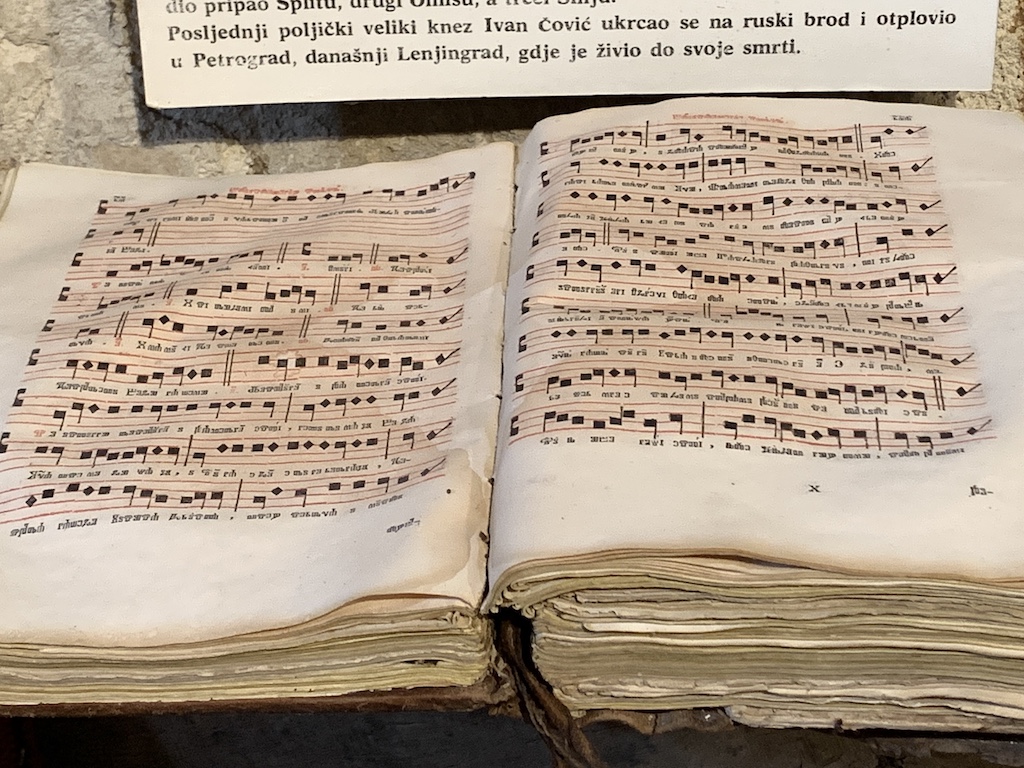 A book preserved from the early days of the Republic is written with the old Glagolitic letters.
A book preserved from the early days of the Republic is written with the old Glagolitic letters.
Poljička Republika
Still with me? Welcome to the Middle Ages and the Poljička Republika, an autonomous community that existed on the land between Omiš and Split for nearly 700 years. This peasant community was self-ruled with an original legal system, a progressive social structure, and independence from the rest of the country. The people’s values are the secret sauce that kept them unified and helped them survive throughout centuries, and boy oh boy do they make an impression.
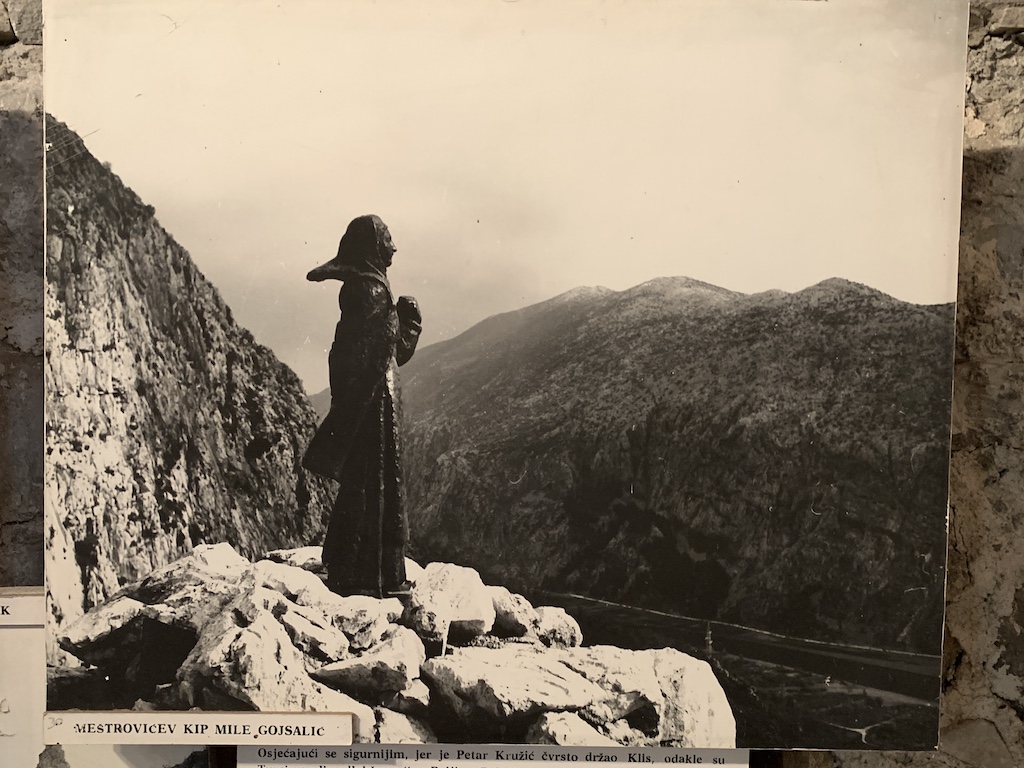 A picture of a picture… a statue of Mila Gojsalić, the young Poljica heroine who helped defeat the Ottomans stands above Omiš; carved by Croatian sculpture Ivan Meštrović.
A picture of a picture… a statue of Mila Gojsalić, the young Poljica heroine who helped defeat the Ottomans stands above Omiš; carved by Croatian sculpture Ivan Meštrović.
Today, their exclusive costumes, novel dance, and unique songs are recognized on UNESCO’s list of Intangible Cultural Heritage. And here’s the culinary piece you’ve been waiting for… The people’s traditional “peasant food,” soparnik, is on the list too and it’s furthermore protected by geographic origin per the European Union. Wow.
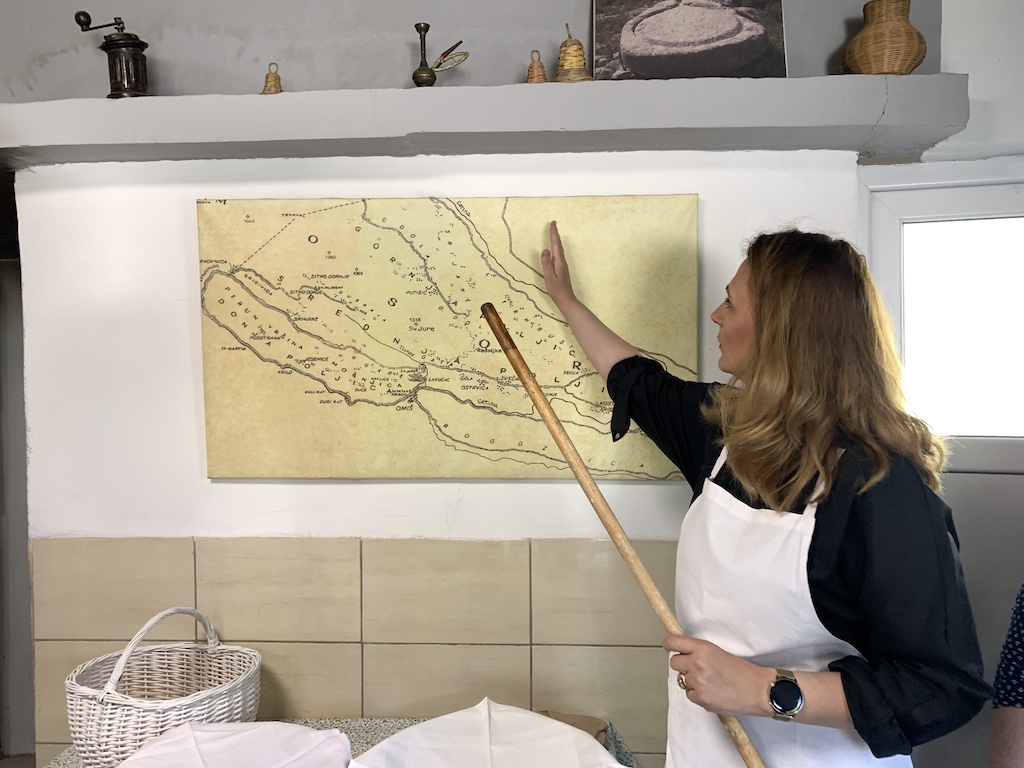 This village kitchen displays a map of the Poljica region, here showing where the Upper, Middle, and Lower territories of the Republic sit around Mosor Mountain.
This village kitchen displays a map of the Poljica region, here showing where the Upper, Middle, and Lower territories of the Republic sit around Mosor Mountain.
Soparnik pie
The humble soparnik pie is a standout for its simplicity and its deliciousness and it’s possibly the best cultural ambassador for the ancient Republic and the current Poljica region. Once considered basic grub for the poor and workers, dating back to the Ottoman Empire, it’s still made from locally grown ingredients in the customary manner of the hinterland, including wooden equipment and an open stone oven.
 A massive oak tree near the Church of St. Cyprian grew up during the heyday of the Poljica Repubic and is thought to range from 400-700 years old.
A massive oak tree near the Church of St. Cyprian grew up during the heyday of the Poljica Repubic and is thought to range from 400-700 years old.
Soparnik is easy and quick enough to make and it consists of flour, water, salt, olive oil, chard, onion, and garlic. So particular are the cooks, they can tell you the difference between onions grown in their back yard versus those on the other side of the mountain. With so few ingredients, this skill is a testament to the resourcefulness of people with little means, using their natural surroundings to create sustenance, which, by the way, happens to be quite tasty and filling.
In the kitchen
In family homes, Grandma Milka teaches granddaughter Mila precisely how to roll the dough on a sinija—a round wooden board that measures 90-110 cm in diameter (35-43 inches)—to get a perfect, thin consistency. She also mentions that the blitva (chard) needs to be dried after being washed so the dough won’t get soggy.
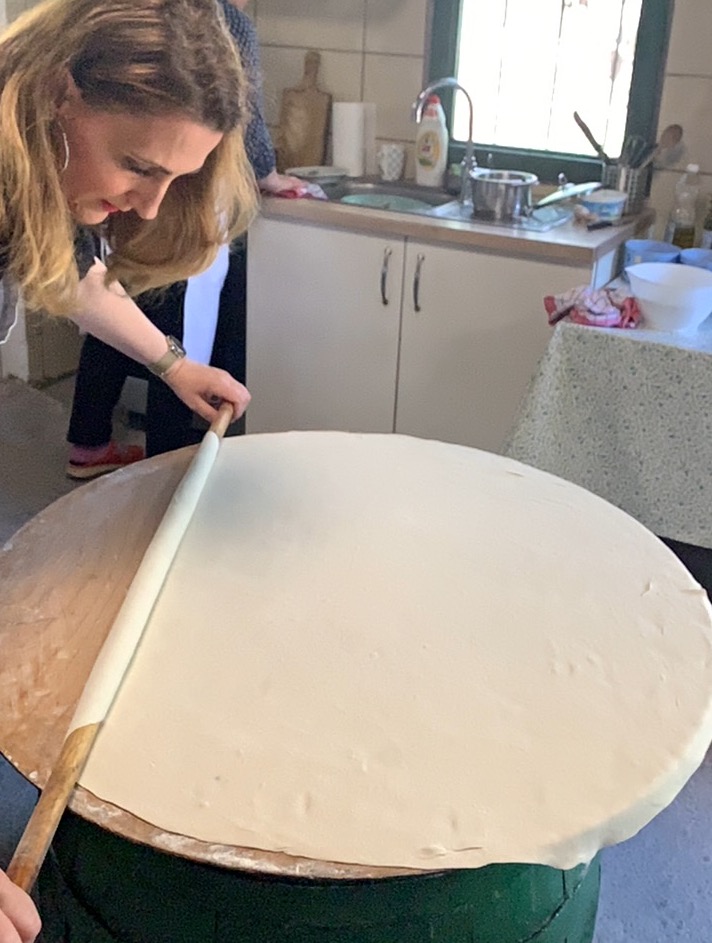 A wood stick and a large wood platter are the basic kitchen equipment for rolling dough.
A wood stick and a large wood platter are the basic kitchen equipment for rolling dough.
If you noticed the similarity of their names, that’s intentional. Boys’ and girls’ names are derived from their grandparents, per an old-world practice that’s still carried out.
Embers and ashes
Back in the kitchen… once the first layer of dough is covered with the vegetable mixture, a second layer is placed on top and the pie is sealed with a braided edge; ready for the oven. Then the massive soparnik is slid off the sinija and onto the hot stone. The next step made me gasp, it was covered with embers and ash. No!
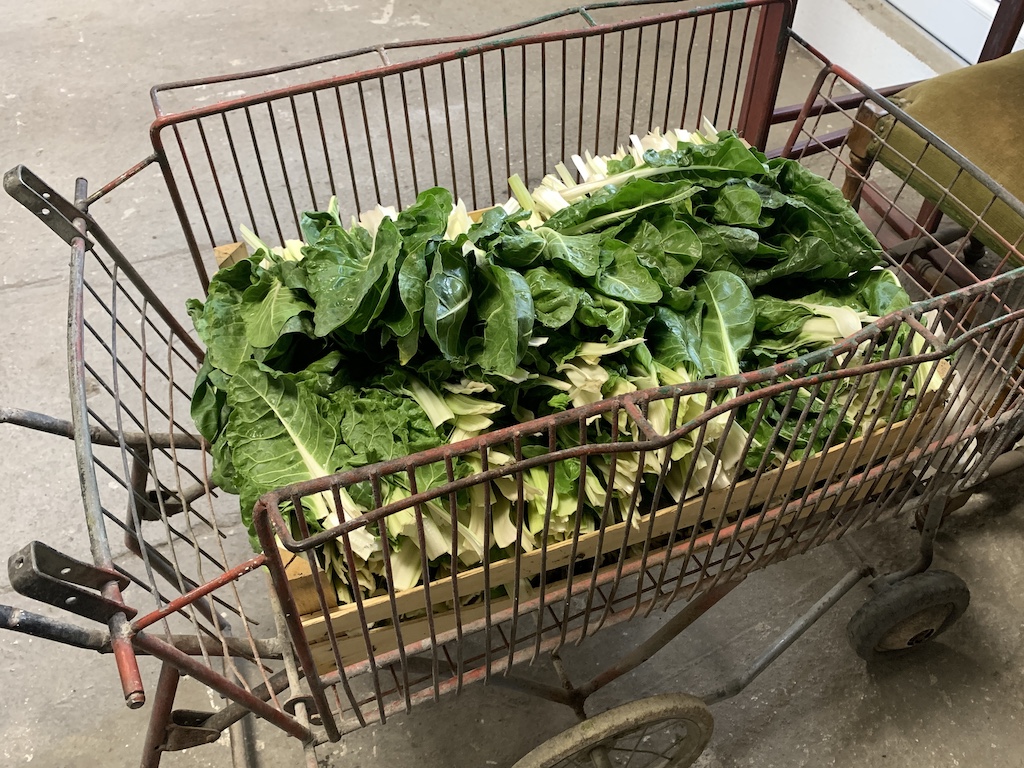 Locally grown chard, a.k.a. blitva in Croatia, is the main vegetable inside soparnik and it’s carefully tripped to remove the hard stem so the thinly sliced pieces cook evenly.
Locally grown chard, a.k.a. blitva in Croatia, is the main vegetable inside soparnik and it’s carefully tripped to remove the hard stem so the thinly sliced pieces cook evenly.
Baking this way for nearly 20 minutes, the pie cooks on top and bottom and picks up a subtle smokey flavor. I appreciated this nuance when I tasted a finished piece, which had the final touches—a coating of Dalmatian olive oil and a sprinkling of raw garlic.
Dalmatian specialty
This traditional Dalmatian specialty symbolizes a specific culture and a way of life. While you eat soparnik, it’s intriguing to let your mind wander back to the Poljička Republika and try and imagine an alternate scenario where somebody else ate the exact same thing, literally, in the same place, hundreds of years ago.
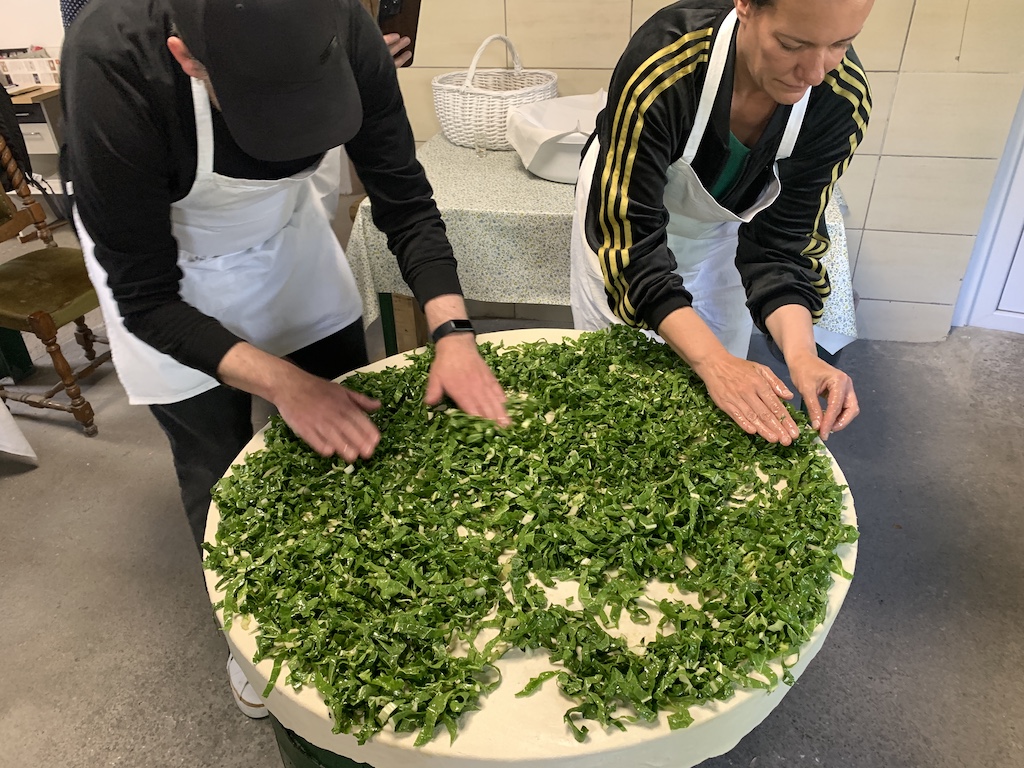 The pie stuffing of chard mixed with onion, salt, and olive oil is evenly spread on the thin layer of dough.
The pie stuffing of chard mixed with onion, salt, and olive oil is evenly spread on the thin layer of dough.
The EU protection helps to make that connection because it guarantees that the soparnik you buy from local markets and festivals is authentic from Poljica.
 Magic happens in a hot stone oven when coal embers and ashes bake the top part of your soparnik and add a subtle smokey flavor.
Magic happens in a hot stone oven when coal embers and ashes bake the top part of your soparnik and add a subtle smokey flavor.
Pizza anyone?
So, if you’re now wondering about another national “pie,” here’s a fun fact. Legend has it that Venetians in Croatia who tasted soparnik back in the day took it home to Italy and it became the inspiration for pizza. What do you think? Dobar Tek!
This experience was another great authentic adventure organized by the Cromads travel club.
Story and photographs ©2022, Cyndie Burkhardt. https://photo-diaries.com
Learn more at TCN’s Digital Nomads channel.
Visit Omis: The Summertime Holiday Winter Dreams Are Made For
17 December 2020 – Missing adventure, escape, breathtaking landscapes and unspoiled nature? Visit Omis in 2021 - with 20 kilometres of perfect beaches and crystal-clear seas, the mighty Cetina river and an atmospheric Old Town, it's the summertime holiday that winter dreams are made for.
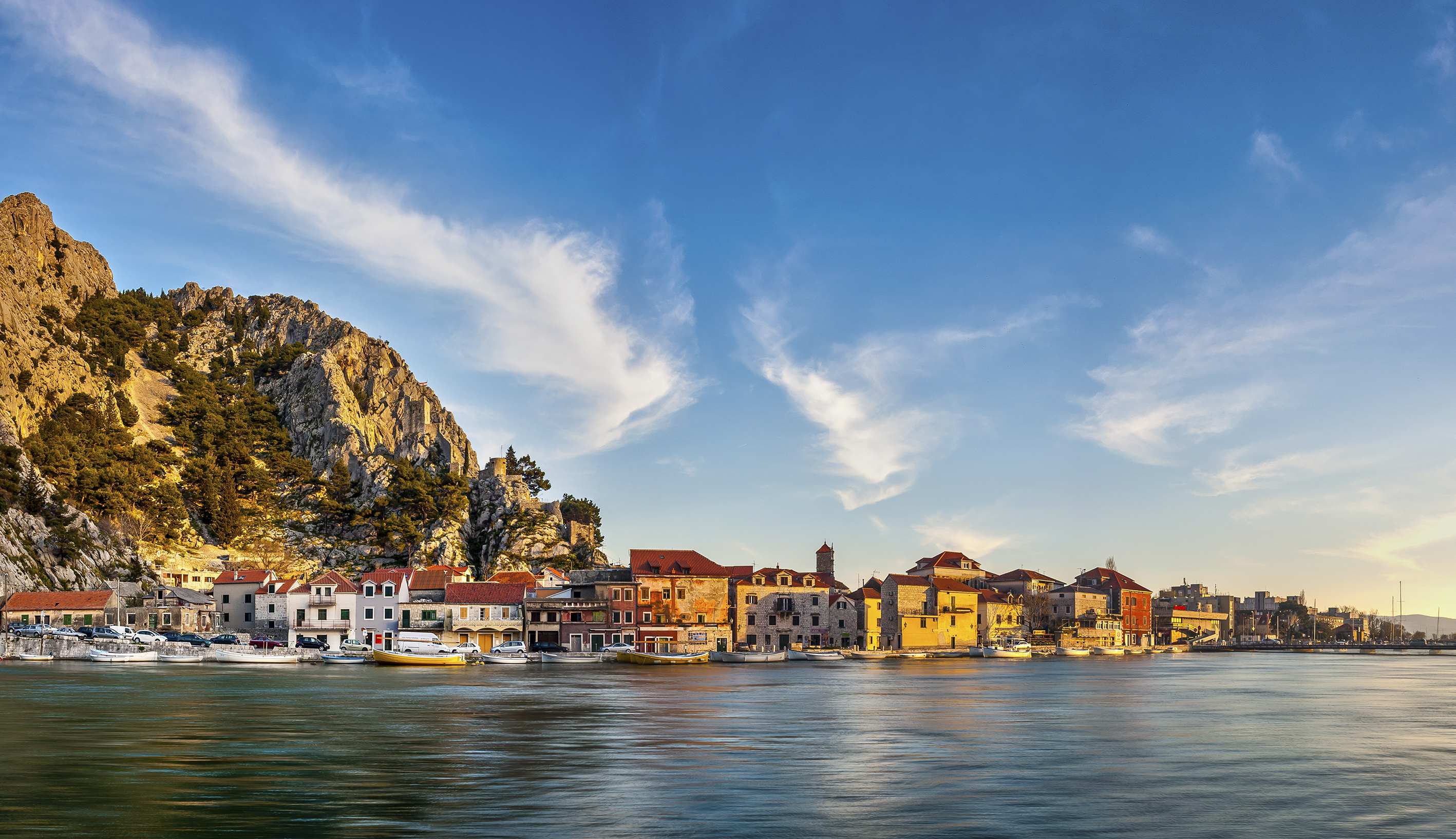 The pretty pastel shades of buildings in Omis contrast beautifully against the sheer, grey, karst rock which rises sharply behind © Omis Tourist Board
The pretty pastel shades of buildings in Omis contrast beautifully against the sheer, grey, karst rock which rises sharply behind © Omis Tourist Board
The cold outside is often reason enough to spend most of winter indoors. It's a good time for wrapping presents or even wrapping yourself in blankets. Perhaps, if it snows, you'll sit by the window, daydreaming. With a chill in the air, there's no better dream than that of next summer. In the warmth of the summer sun, you can forget all about those blankets and staying indoors. It's time for escape, adventure, the great outdoors, to hit the beach and to swim in the sea. Crystal-clear waters run along the length of the Omis riviera © Omis Tourist Board
Crystal-clear waters run along the length of the Omis riviera © Omis Tourist Board
In 2021, the City of Omis will once again welcome winter's dreamers. From Springtime to October, visitors will come and enjoy its extended summer, many of them returning as they do every year. Because, once you visit Omis, there really is nowhere else that can match its incredible offer.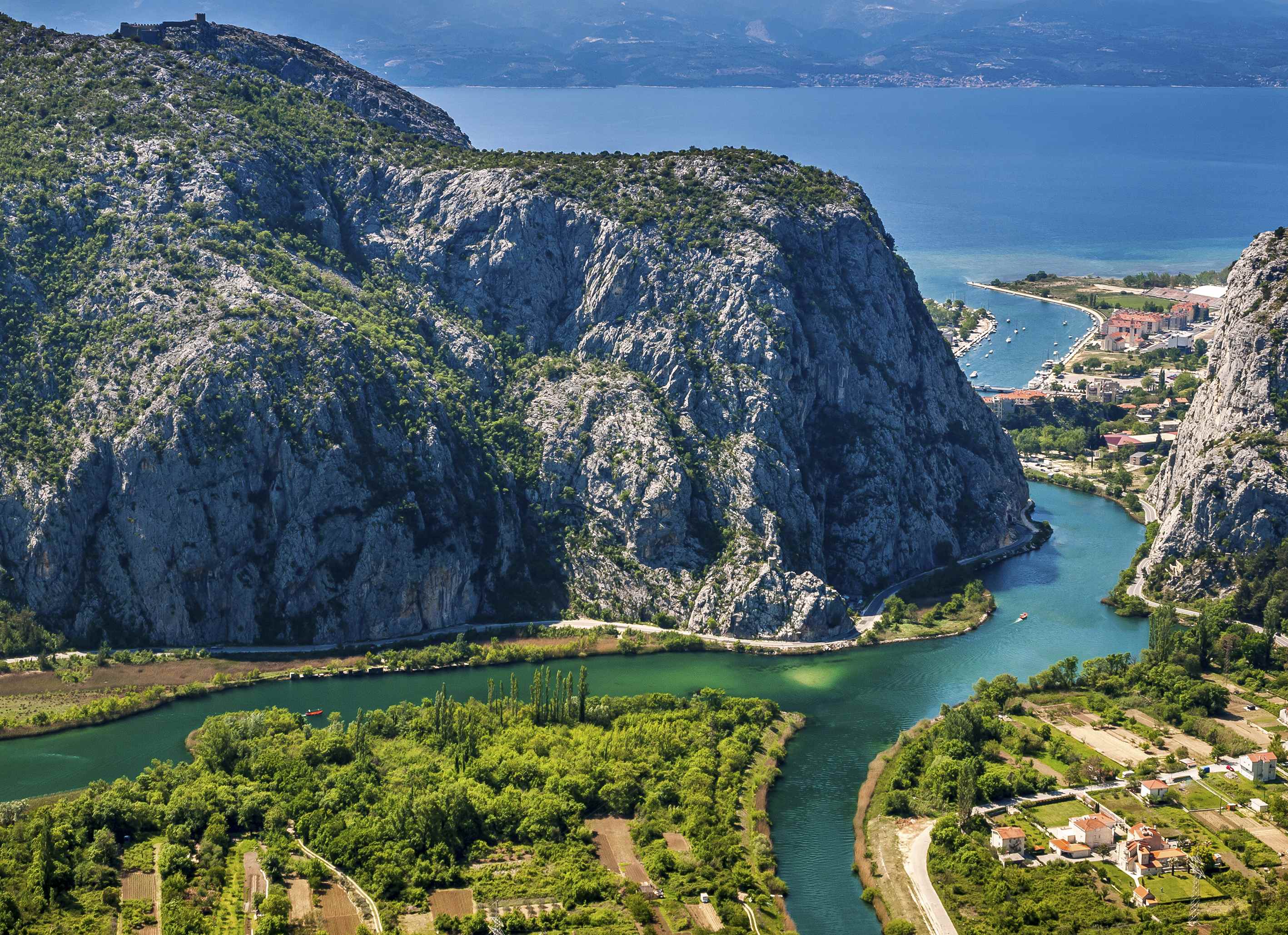 A spectacular landscape, with the lush Cetina river valley cutting through the Dinaric Alps to flow into the sea at Omis - you can see the island of Brac in the distance © Omis Tourist Board
A spectacular landscape, with the lush Cetina river valley cutting through the Dinaric Alps to flow into the sea at Omis - you can see the island of Brac in the distance © Omis Tourist Board
The unique experience when you visit Omis is a product of a singular history and geography. Standing on the mouth of the Cetina - the largest river in Croatia to drain into the Adriatic – Omis and its surrounding riviera is not only filled with pristine and peaceful beaches, it also has waters that, for hundreds of years, have connected the city far into the hinterland. When you visit Omis, it is this riverside positioning that gives its unmissable adventures, culture, heritage and nature.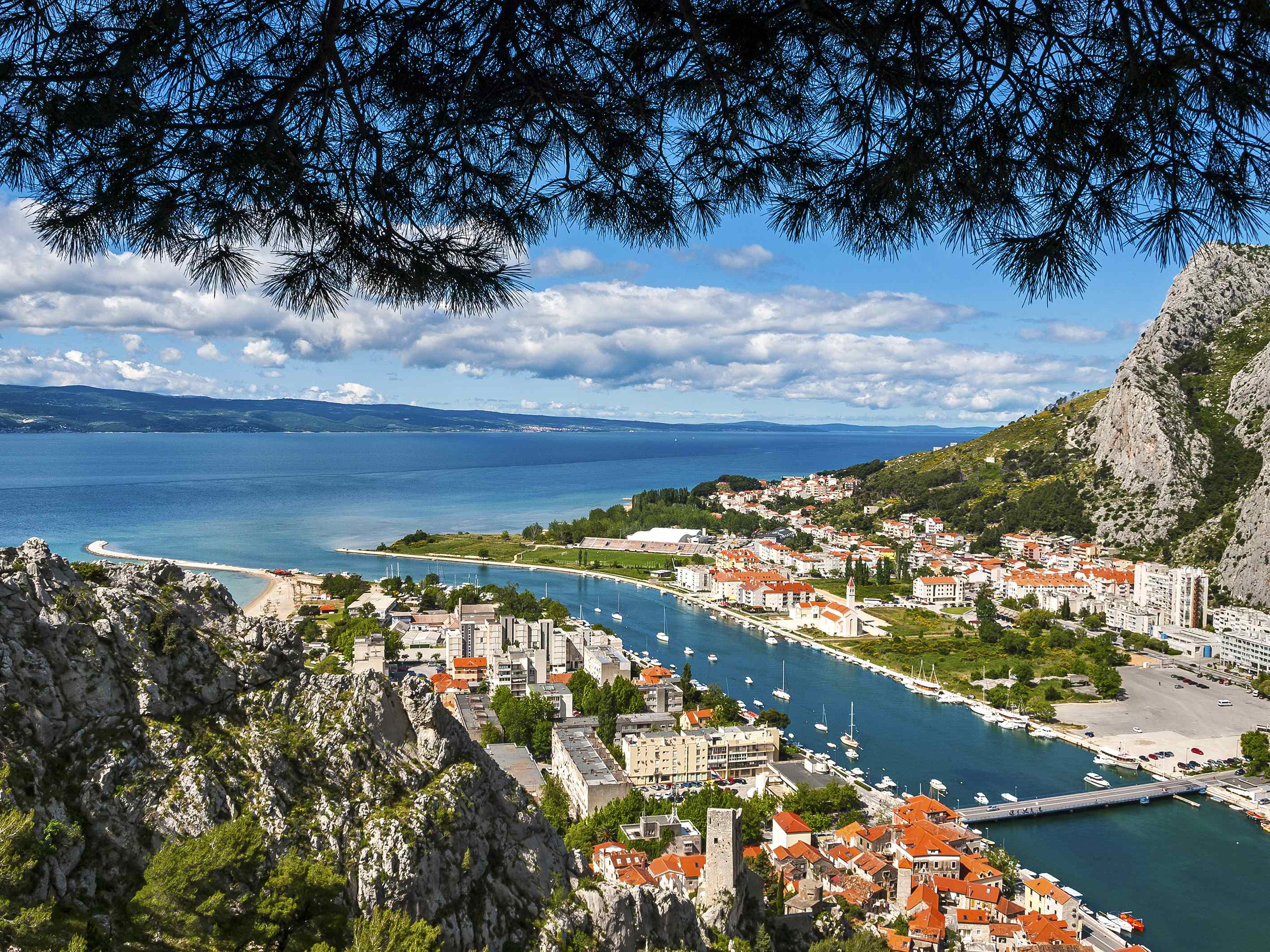 The Cetina river is the largest to flow into the Adriatic in Croatia and helps give Omis a truly unique offer © Omis Tourist Board
The Cetina river is the largest to flow into the Adriatic in Croatia and helps give Omis a truly unique offer © Omis Tourist Board
Omis has been inhabited since at least Roman times. Today, the winding, narrow streets of its Old Town are a pretty promenade with a distinctly Mediterranean atmosphere. Walking down these stone-paved pathways, intriguing architecture built over centuries is revealed – an unexpected city square opens up, seating drinkers and diners. Above them, the walls of an ancient church and beyond, the spectacularly lit Mirabella fortress that stands impressively above the town. You can easily walk to the top and look over the Old Town and river or, by day, take the path further back, up to the 15th century Starigrad Fortress. Its walls are renowned to hold one of the greatest views in Croatia, the island of Brac dominating the skyline, further still, the island of Hvar. Both can be toured by boat on day trips when you visit Omis.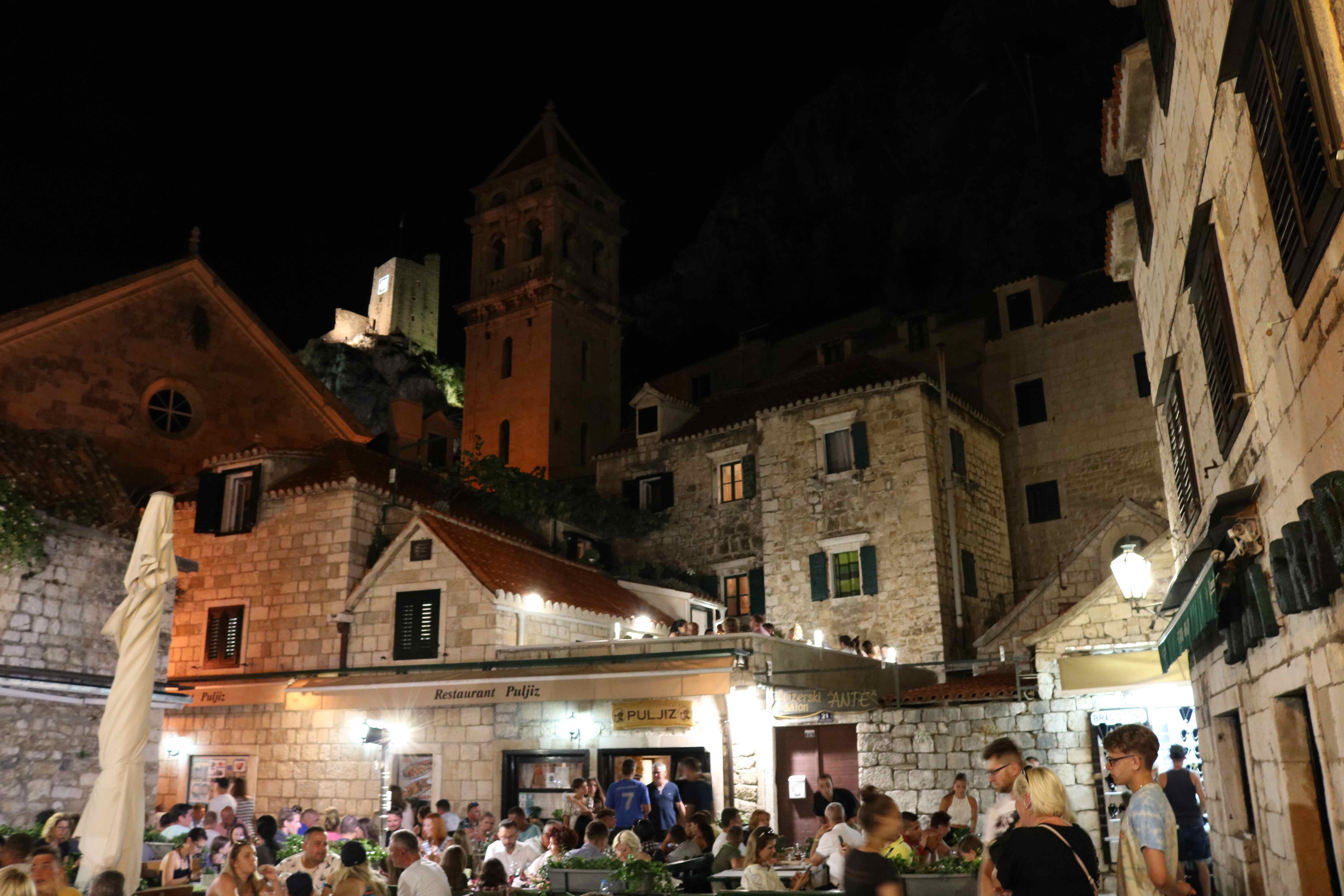 The atmosphere-filled Old Town of Omis © Marc Rowlands
The atmosphere-filled Old Town of Omis © Marc Rowlands
Besides venturing out to sea by boat, taking to the waters of the Cetina river is the best way to get the most from the unique offer when you visit Omis. You can kayak from the town into the nearest sections, watching as the pastel shades of Omis buildings are replaced by the towering, epic cliffs of grey karst rock, sometimes dotted with brave and experienced free climbers. Then, suddenly, the river widens to become flanked by reeds, then fields and trees. Birds sit atop the water or fly overhead, fish dart below you in crystal-clear waters, insects and frogs can be heard coming from some hidden place. The whole landscape seems alive, yet silent except for the sounds of nature – you can't hear a single car engine, not the buzz of an overhead cable, only the dipping of your oar in the calm waters.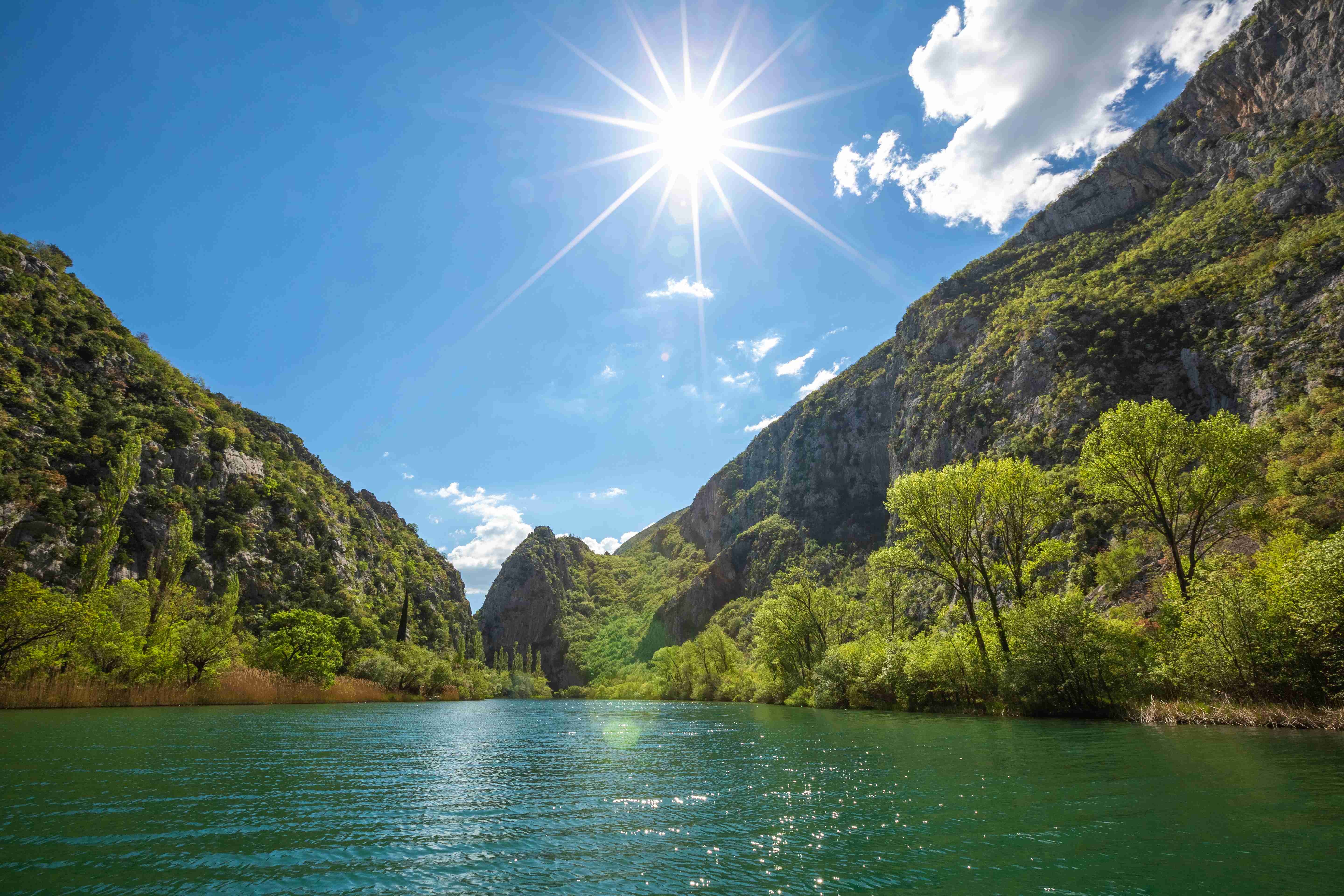 The still and silent Cetina river valley near Omis, perfect for kayaking and reconnecting with nature © Samir Kurtagić / Omis Tourist Board
The still and silent Cetina river valley near Omis, perfect for kayaking and reconnecting with nature © Samir Kurtagić / Omis Tourist Board
Further up the river, the sounds are not so silent. Thrillseekers scream as they fly down the longest run of ziplines in Croatia – a series of eight lines, at times rising 150 metres above the river, the scenery of mountains and surging river is breathtaking, as feet whistle over high treetops. Further up the river, rapids produce white waters perfect for rafting. Although an action-packed run of over two-hours duration, it's an undemanding course taken by many families with children as young as six. Between the fast-moving sections are waterfalls that spray the air and peaceful pools where you pause to swim. At one of the largest stands a huge picnic area, serviced by a restaurant specialising in the rustic cuisine of this part of the Dalmatian hinterland. Thick-crusted, homemade bread is made within metal bells atop wood fires, the perfect accompaniment to local cheeses, prosciutto and seafood.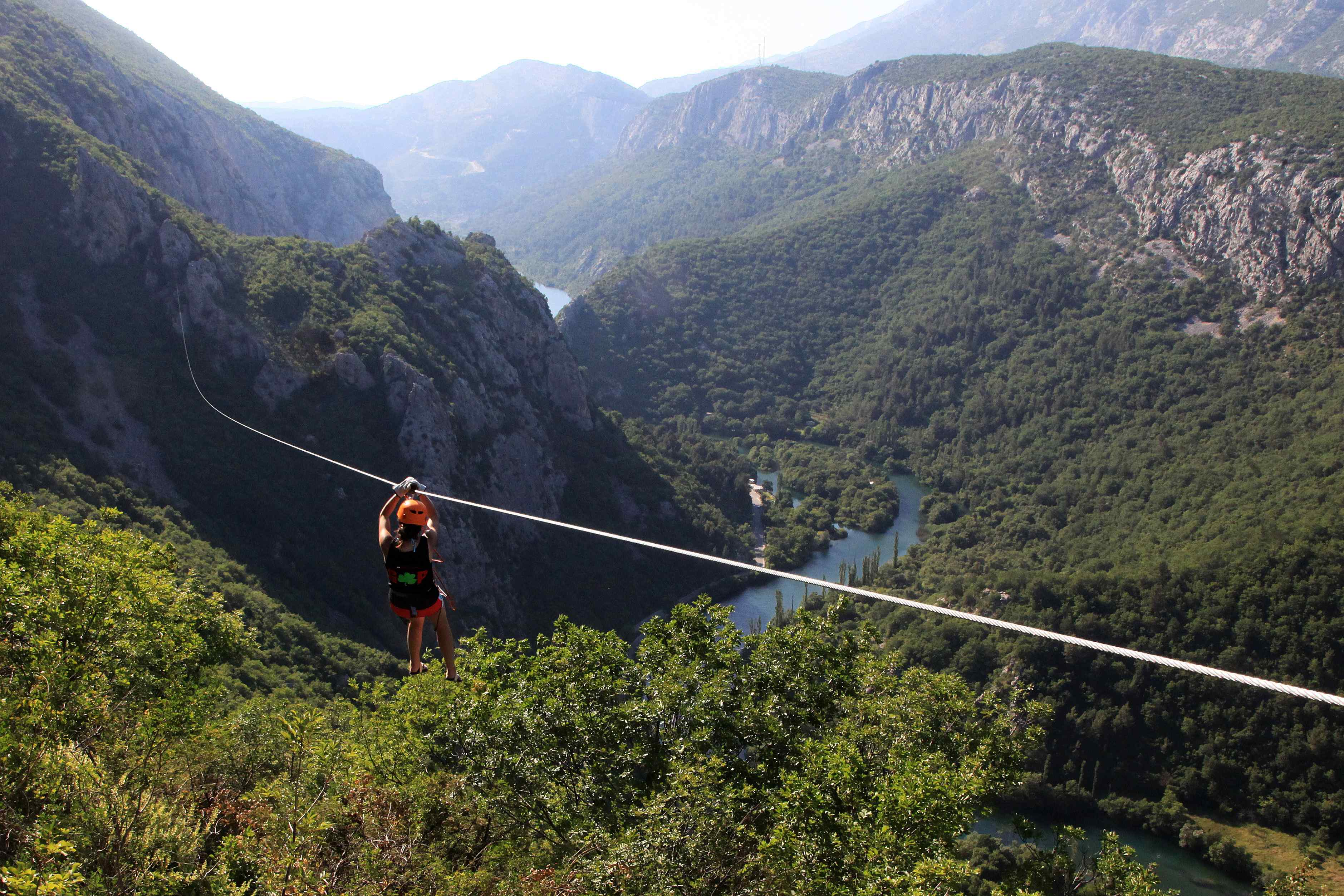 © Zipline Croatia
© Zipline Croatia
Here, away from the shoreline of the town, countless small villages appear on the roads between the river and mountains. Life in these villages looks remarkably like it did a few hundred years ago. The same fruits and vegetables and vines still grow around the traditional houses, many of them ending up on the tables of the fine restaurants you'll dine in when you visit Omis. The same meals are prepared, such as Soparnik, one of Croatia's most authentic dishes – you can only find it in the small region surrounding Omis. The same folk dances are preserved, and the same songs fill the air. You can hear many of them in Omis itself – the city hosts a famous 55-year-old festival of klapa (acapella) music, its singers dressed in traditional clothes, their voices echoing around the stone streets of the Old Town in the same way they have for hundreds of years. The chamber music evenings and one of the most important guitar festivals in the region add to the wonderful entertainment and atmosphere of balmy summer evenings you have when you visit Omis.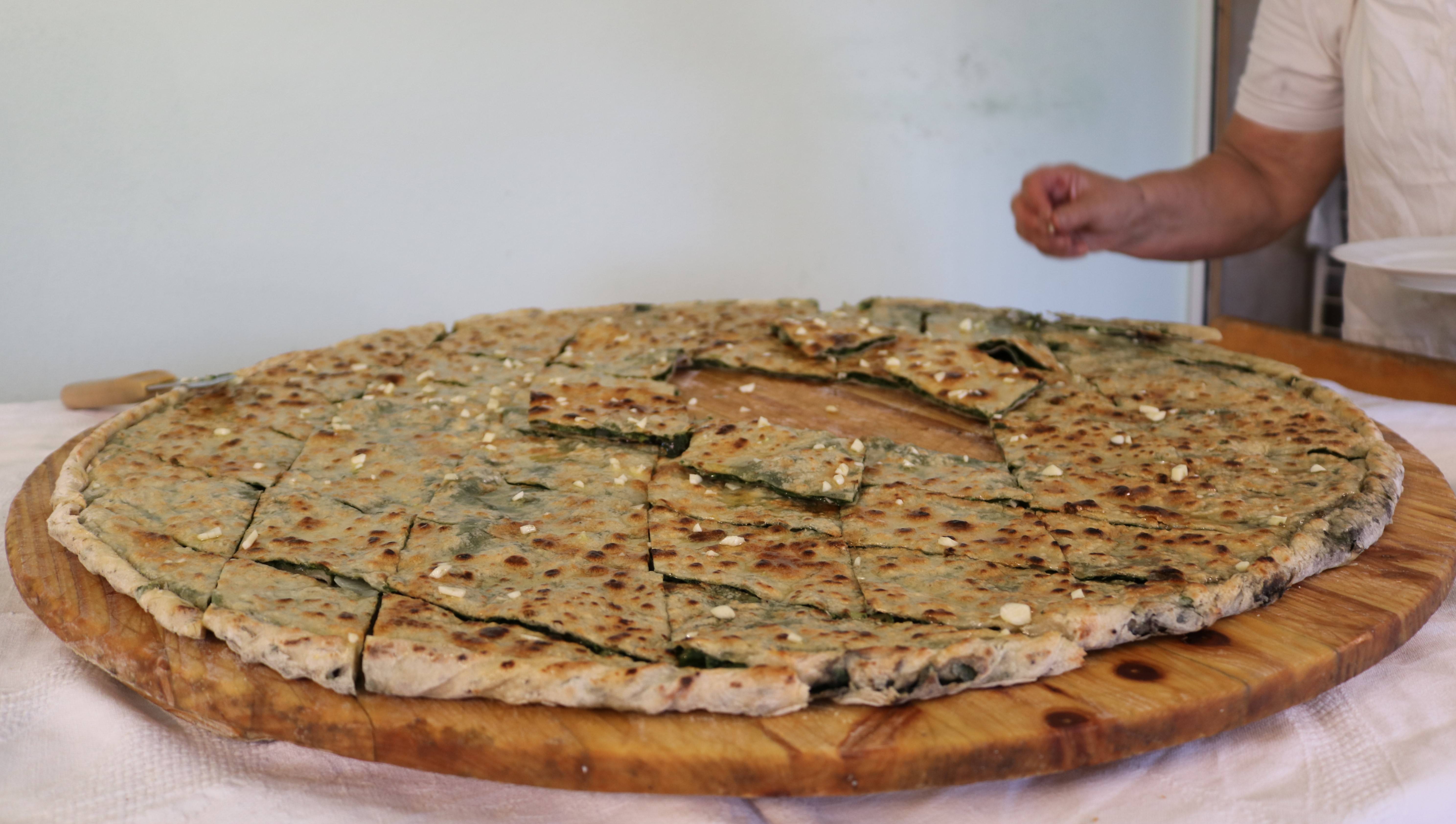 Soparnik, one of the most authentically Croatian foods in the country. It comes from the hinterland behind Omis and it's unlikely you'll find it anywhere else © Marc Rowlands
Soparnik, one of the most authentically Croatian foods in the country. It comes from the hinterland behind Omis and it's unlikely you'll find it anywhere else © Marc Rowlands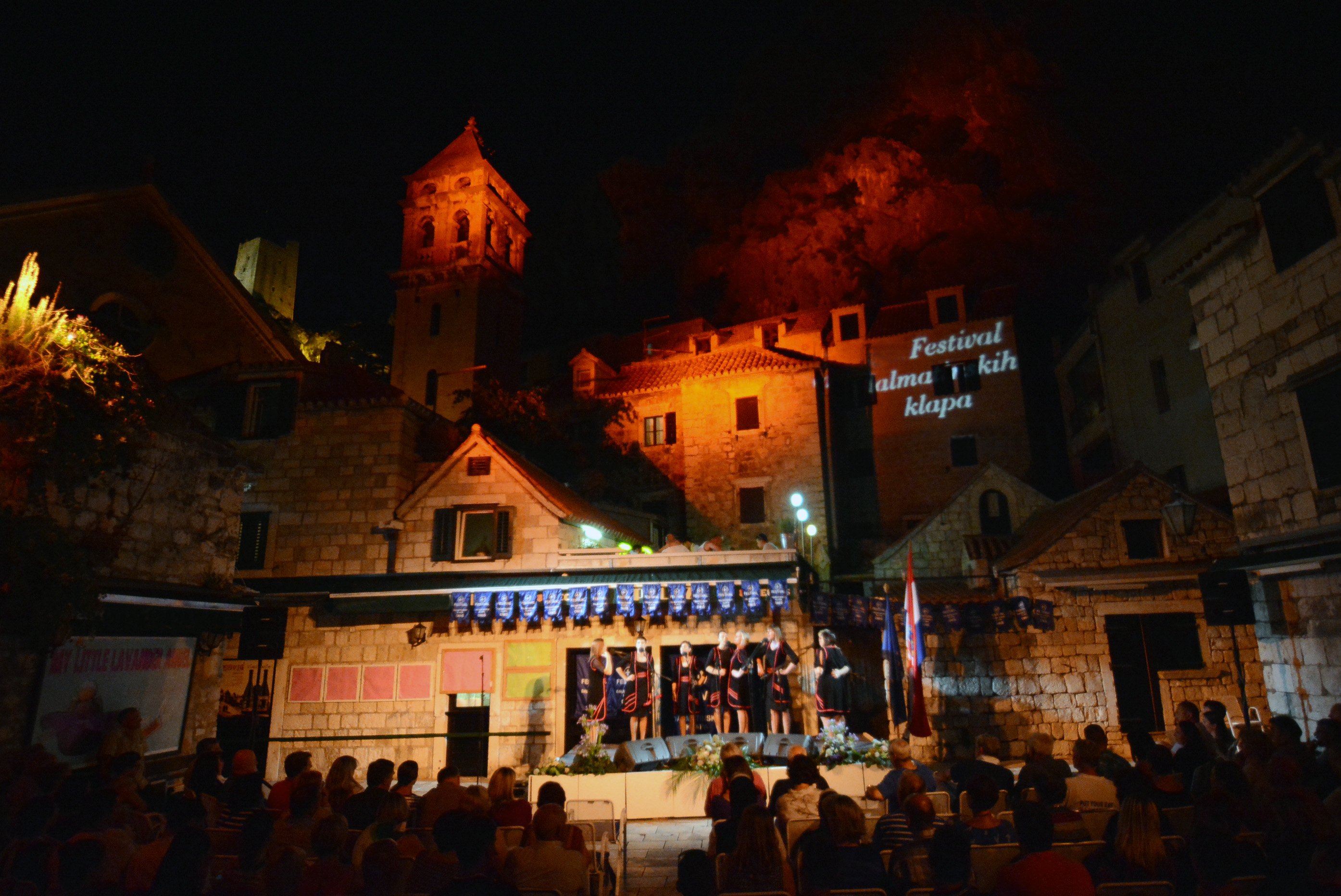 The 55-year-old festival of klapa music in Omis © Omis Tourist Board
The 55-year-old festival of klapa music in Omis © Omis Tourist Board
Of course, no trip to the Adriatic is complete without time spent on the beach and swimming in the sea. And, when you visit Omis, you're in one of the best places anywhere in Croatia to enjoy it. Relatively undiscovered, the Omis riviera has a wide range of options to suit all. Want to stay close to town? Visit Omis city beach – it's right on your doorstep, popular with families and its waters famously clean. It is extremely rare to find a huge sandy beach like this, right in the heart of the city.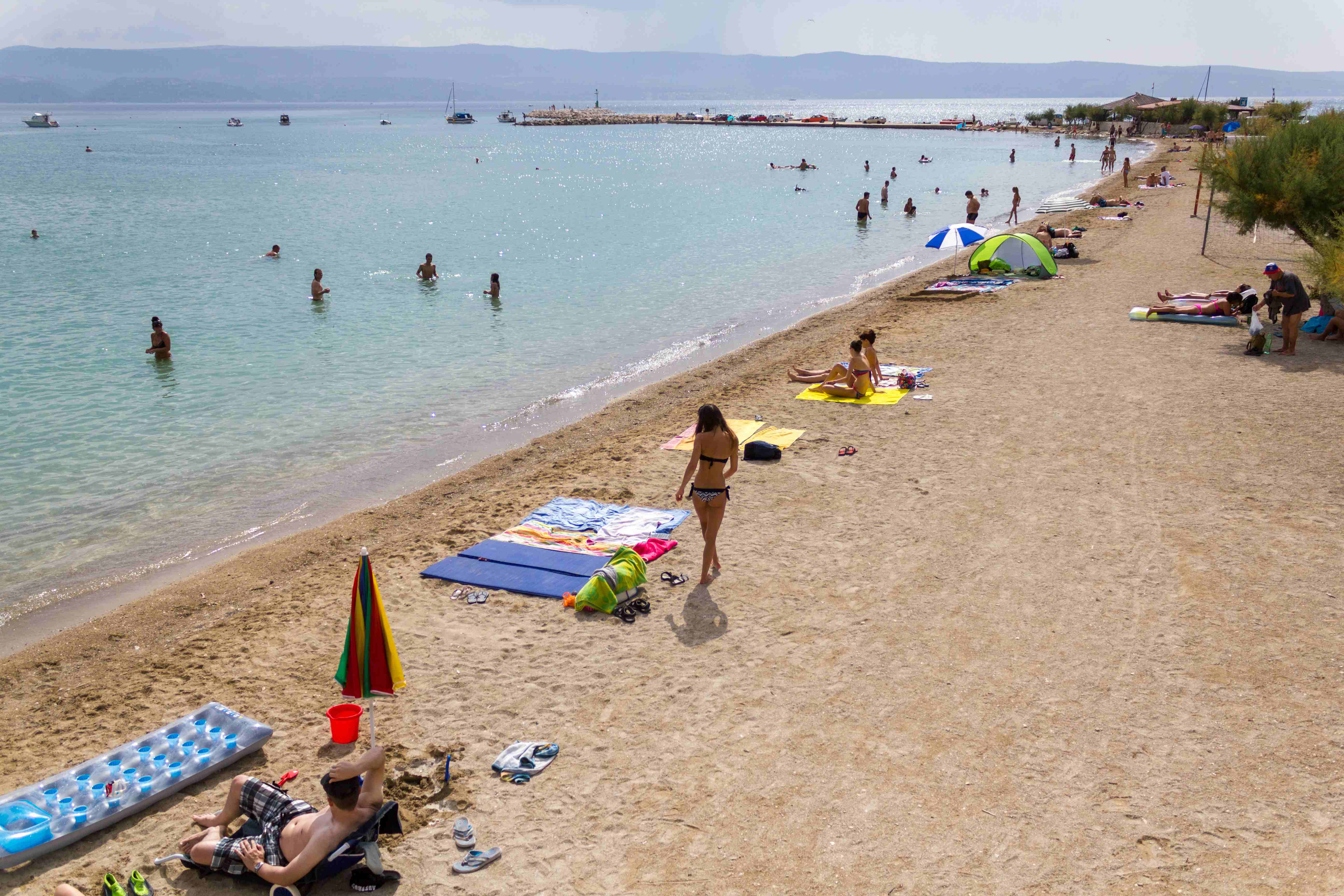 Omis city beach, a huge stretch of sand, moments walk from the centre - there's plenty of room for everyone © Omis Tourist Board
Omis city beach, a huge stretch of sand, moments walk from the centre - there's plenty of room for everyone © Omis Tourist Board
A short ride down the coast offers a 20-kilometre stretch of perfect small-pebble beaches, shaded by scented pine trees, sitting on impossibly clear waters. Pretty hamlets and fishing villages like Nemira, Stanici, Ruskamen, Lokma Rogoznica, Medici, Mimice, Marusici and Pisak allow you to chose between peaceful seclusion, diving and watersports or flavour-packed lunchtime dining in a traditional Dalmatian tavern.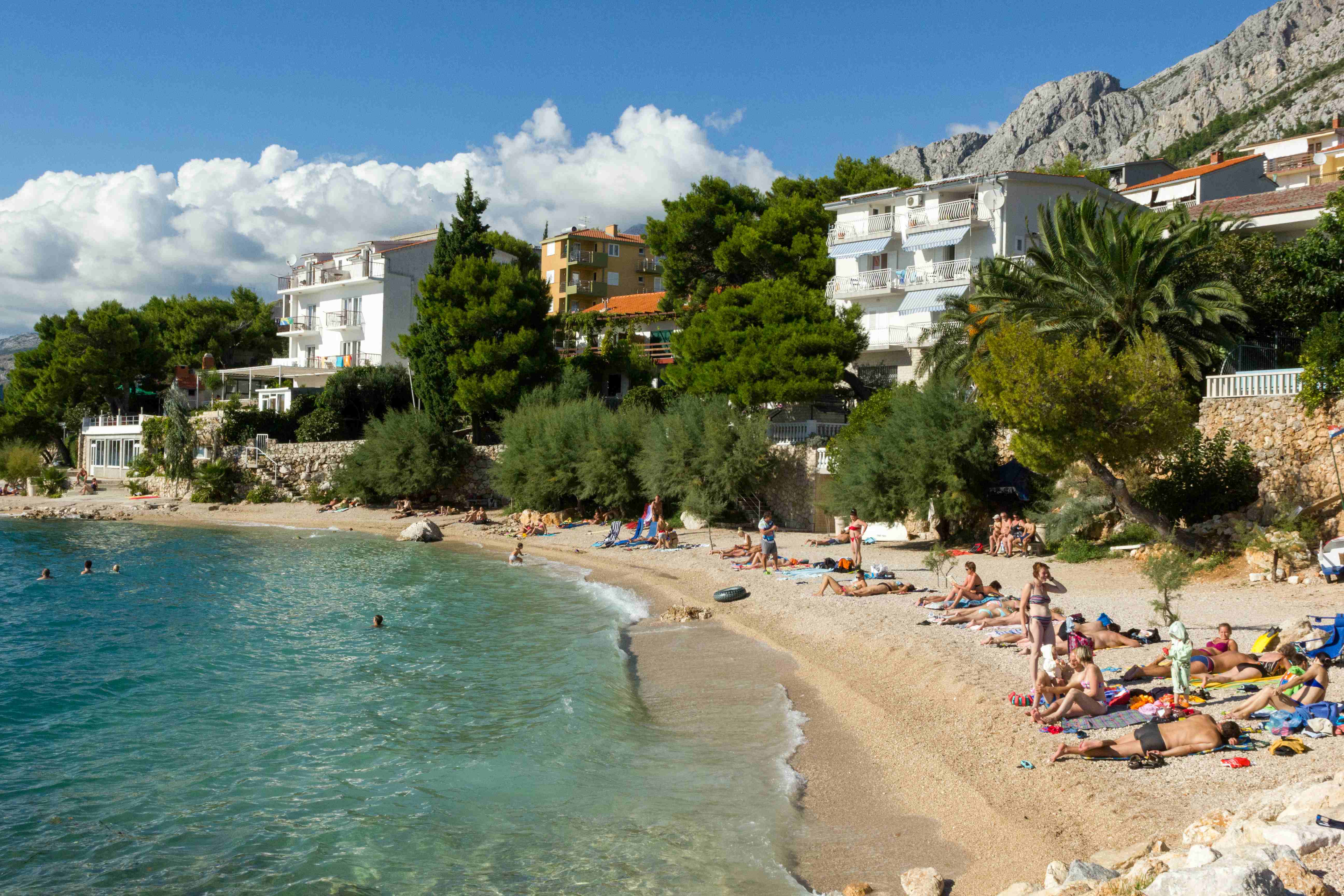 The village of Nemira, one of the countless pristine beaches along the 20 kilometres of the Omis riviera © Omis Tourist Board
The village of Nemira, one of the countless pristine beaches along the 20 kilometres of the Omis riviera © Omis Tourist Board
This winter has long to go. We will be inside for quite some time yet. But, that gives us plenty of time to dream of next summer. Of all the places you think you'd like to be, once the warm days return, the City of Omis and its riviera should be top of the list. Unique in its offer of adventure, nature, culture and heritage, there really is nowhere else like it on the whole of the Adriatic.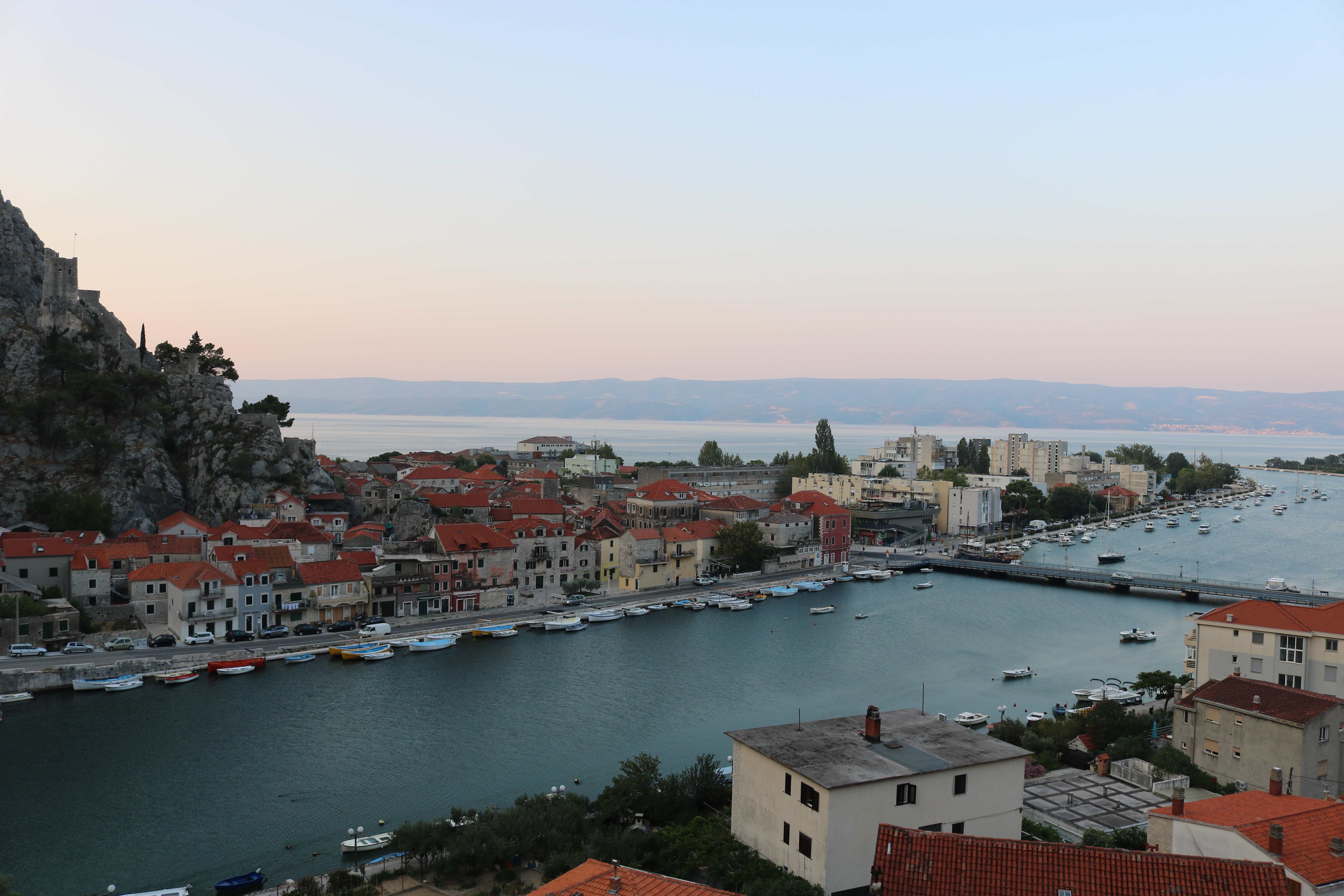 Daybreak over Omis, as seen from the restaurant balcony of Hotel Villa Dvor. The hotel's restaurant is the best place to take coffee in town, the view is spectacular © Marc Rowlands
Daybreak over Omis, as seen from the restaurant balcony of Hotel Villa Dvor. The hotel's restaurant is the best place to take coffee in town, the view is spectacular © Marc Rowlands
This article was written by TCN journalists based on first-hand experience of visiting Omis and was subsequently approved by Omis Tourist Board
Day of Culinary Heritage to be Marked in Split with Soparnik!
November 9, 2018 - The public institution RERA, with the support of the Split Tourist Board, is organizing the Day of Culinary Heritage of Split-Dalmatia County, which will be held on Tuesday, November 13 from 10 am to 8 pm at Prokurative (Trg Republike) in Split.
As part of the project, 'Poljički Soparnik' will be presented, which is a part of the protected intangible heritage of the Republic of Croatia.
What is Poljički Soparnik, you might ask? Soparnik is a savory pie with a filling of Swiss chard, onions and parsley. The famous dish originated from the 15th to 19th century, during the Ottoman Empire.
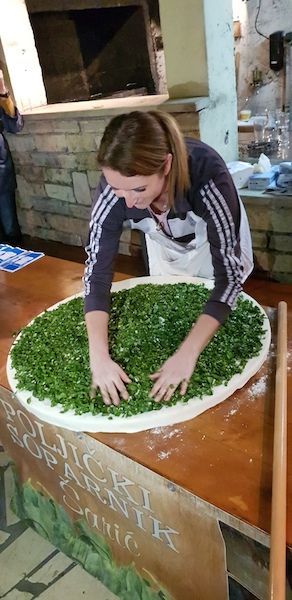
Do you want to learn how to make and bake this popular pie?
Do you want to buy products with an internationally recognized symbol of tradition and quality of Croatia’s culinary heritage?
Come to Prokurative on Tuesday, November 13!
To learn more about Soparnik, click here.
American Forbes Publishes a Love Letter to Split
American Forbes journalist, Ann Abel, published a love letter to Croatia in Forbes, giving her “8 reasons to be smitten with Split.”
Watch the Full Episode of Bizzare Foods with Andrew Zimmern on Trilj and Strmendolac
(photo: Meat Shopping in Croatia / Travel Channel)
It is finally here. The full episode of Bizzare Foods with Andrew Zimmern on Croatia, including Strmendolac and Trilj (approx. from the 16th minute). I am just so hungry after watching it. The show is absolutely fantastic. I want to taste all of the fabulous food they prepared, it looked so delicious. Food prepared in the old traditional way is just the best. As Andrew said, you actually can´t eat this kind of food anywhere else in the world. There is not a place in the world like Strmendolac.


